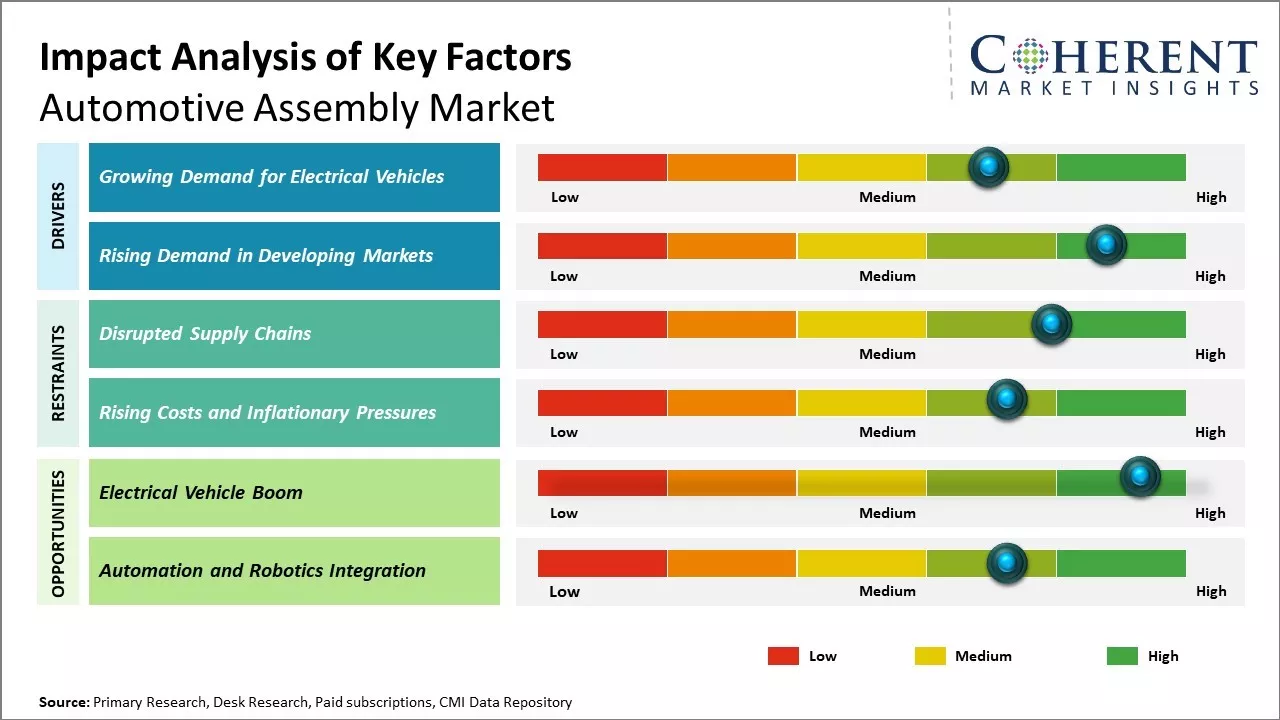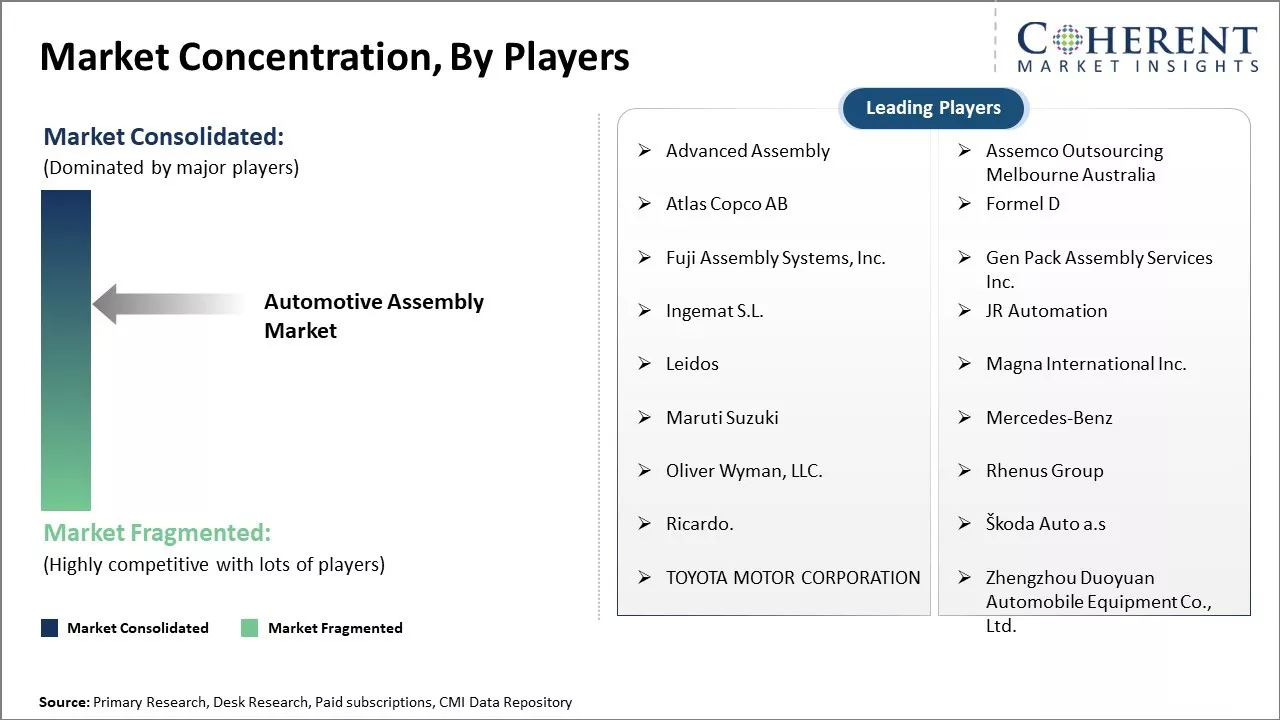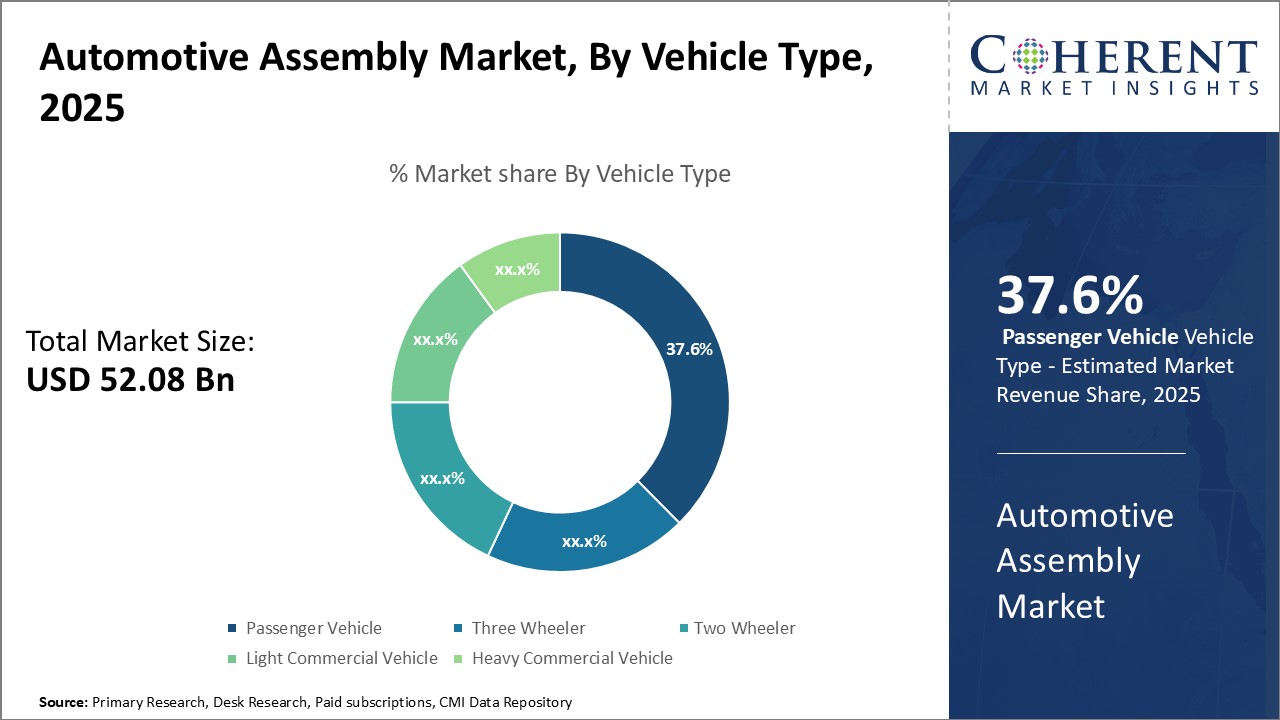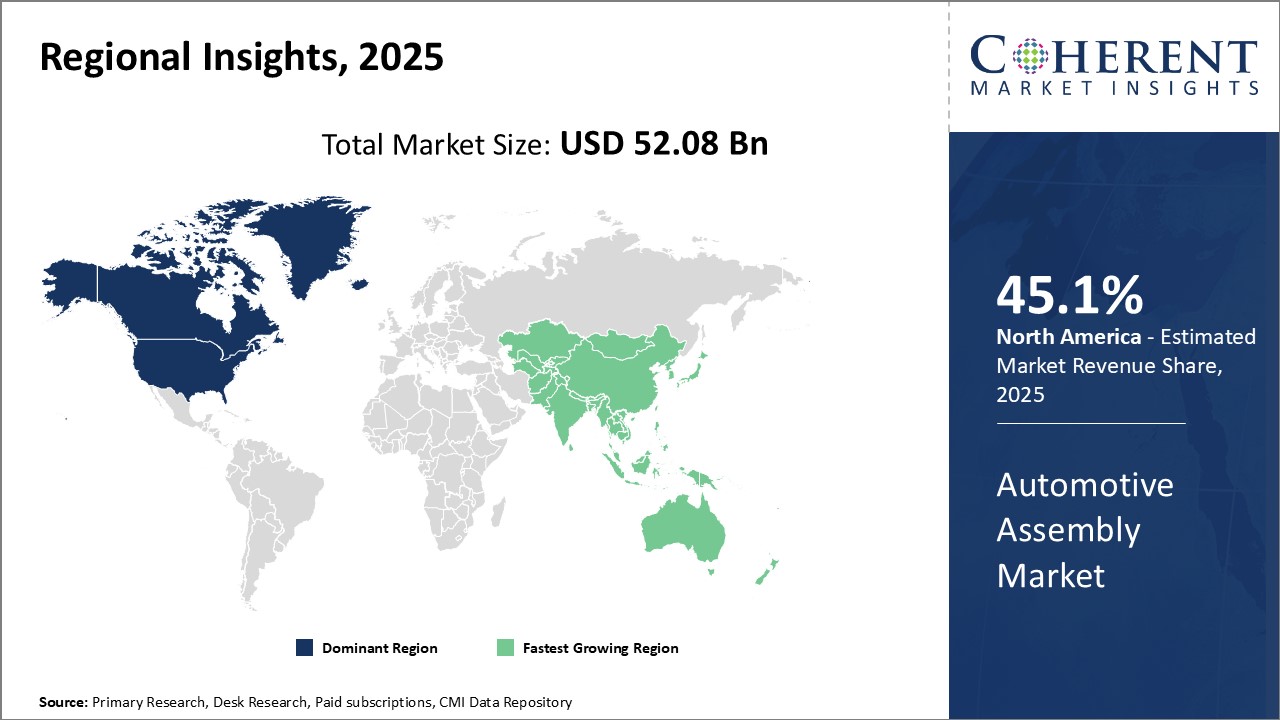Global automotive assembly market is estimated to be valued at USD 52.08 Bn in 2025 and is expected to reach USD 78.36 Bn by 2032, exhibiting a compound annual growth rate (CAGR) of 6.0% from 2025 to 2032.

Discover market dynamics shaping the industry: Download Free Sample
Major automakers are investing heavily in developing electric vehicle models and technologies to transition from internal combustion engine vehicles. Government support through subsidies and regulations also boosts the adoption of electric vehicles in regions like Europe to reduce emissions. Furthermore, rising environmental concerns and decreasing battery prices are making electric vehicles an attractive alternative for consumers. This rising demand for electric vehicles is expected to drive the automotive assembly market growth in the near future.
Growing Demand for Electric Vehicles
The automotive industry has witnessed a gradual shift towards more environment-friendly vehicles. Stricter emission norms around the world are pushing automakers to invest heavily in developing electric vehicles. Consumer preferences are also changing as people are becoming more conscious about the environmental impact of their commute. Electric vehicles are now seen as a viable alternative to conventional internal combustion engine vehicles, especially for daily city driving. Most major automakers have announced ambitious electric vehicle expansion plans over the next decade to cater to growing demand. New EV models are being rolled out across various vehicle segments attracting more customers. Governments in several countries are offering purchase incentives and subsidies for electric vehicles to further encourage their adoption. Factors like lower operating costs and maintenance are making electric vehicles an attractive option for both individual buyers and fleet operators. With technology advancements, range anxiety issues are also getting addressed to some extent, bolstering customer confidence in EVs. If this growing transition towards electric occurs at a rapid pace in the near future, it can significantly impact automotive assembly operations as electric powertrains require different components and manufacturing processes compared to traditional vehicles. Automakers will need to ramp up investments in electric vehicle production lines and re-skilling their workforce to gain from this market shift.
For instance, according to the report published by International Energy Agency (IEA),global electric vehicle sales had increased by 10 million units in 2022. There was a 35% increase in sales in 2023, pushing the total to 14 million units. This rapid growth has elevated electric cars' market share from 4% in 2020 to 14% in 2022, with expectations to climb to 18% in 2025.

Get actionable strategies to beat competition: Download Free Sample
Rising Demand in Developing Markets
Rising demand for vehicle from developing economies can drive the market growth. Countries like India, Brazil, Mexico, Indonesia and others are witnessing strong economic growth and improving income levels, thus, creating a burgeoning middle-class population. As disposable incomes rise, more people in these emerging markets now have the purchasing power to buy personal vehicles instead of relying on public transport. Inadequate public infrastructure in such developing nations is also driving individual vehicle ownership. Automakers are making focused investments in these high growth regions to capitalize on the market opportunity. These are establishing local manufacturing plants as well as sourcing auto components from within the country to cater to the indigenous demand. Stringent local sourcing regulations in large developing markets like India encourage automotive assembly within the country. Moreover, automakers are rolling out more affordable entry-level models designed specifically for price-sensitive customers in emerging markets. If economic and infrastructure development continues at the current pace, rising vehicle demand from developing regions will remain a major driver propelling future growth of the global automotive assembly industry. For instance, according to the report published by Olx Crisil Mobility, following a remarkable 27% growth in FY23 with 3.9 million units sold, passenger vehicle (PV) sales in India are anticipated to increase at a more moderate pace of 6-8% in FY24,. Growth rate of 5-7% compound annual growth rate (CAGR) is expected in 2024. India's PV sales continue to progress steadily, outpacing many other markets that are still struggling to recover to pre-pandemic levels. Car dispatches exceeded 300,000 units every month throughout the entirety of 2023, a first in the calendar year.
Key Takeaways from Analyst:
Global automotive assembly market growth is driven by favorable economic conditions and rising disposable incomes in developing regions. Higher vehicle demand from emerging markets like Southeast Asia, India and China is can drive the market growth. There has been opportunities for companies to set up or expand operations in these fast growing automotive hubs to cater to local demand. Meanwhile, stricter emission norms can hamper the market growth as manufacturers focus on developing electric and hybrid powertrain technologies to comply with regulations.
North America dominates the market. On the other hand, the Asia Pacific region dominates global vehicle production led by China, which has firmly established itself as the world's largest automotive market. Other high potential nations in Southeast Asia like Thailand, Indonesia and Vietnam are also emerging as attractive destinations. In Europe, Germany stays a dominant force while the U.K. struggles with Brexit challenges in the near term.
Market Challenges: Disrupted Supply Chains
Automakers are facing a triple threat from disrupted supply chains, rising costs, and a rapidly changing landscape. The pandemic has caused critical component shortages, while stricter emissions regulations demand investment in new green technologies. Adding to the pressure, competition is heating up as electric vehicles become more popular, with new entrants vying for market share.
Market Opportunities: Electric Vehicle Boom
Growing demand for personalized mobility options is expected to boost demand for newer vehicle variants. The push for sustainable transport is directing more consumers toward electric vehicles. EV sales are expected to rise sharply in this decade, incentivizing greater investments. Manufacturers investing in advanced automation and robotics can optimize productivity and quality. The emergence of connected cars also opens possibilities to develop new product features and after-sales services.

Discover high revenue pocket segments and roadmap to it: Download Free Sample
In terms of vehicle type, passenger vehicle segment dominate the automotive assembly market due to rising personal incomes and urbanization
By vehicle type, passenger vehicle segment is expected to contribute the largest share of 37.6% in 2025 due to rising personal incomes in developing countries, which increases discretionary spending on personal transportation. As people's financial situations improve, more people are able to afford their own vehicles rather than relying on public transport or car-pooling. This rising affluence is creating a huge middle class population with substantial purchasing power.
Urbanization is another major factor propelling passenger vehicle demand. Many people are moving from rural areas to cities for employment and education opportunities. Living in densely populated urban centers makes it more convenient to own a private vehicle for mobility rather than depending on unreliable public transit systems. Rapid infrastructure development in tier-2 and tier-3 cities across nations like India and China is enabling this urban population boom. The growing connectivity between cities through expanding road networks is also encouraging car ownership.
Younger consumers see owning a car as a status symbol representing their achieved socio-economic status. Automakers regularly launch new models with premium features and stylish designs targeted at the aspirations of this generation. Additionally, features like increased passenger space, improved safety and technological conveniences like connectivity and navigation systems enhance the in-vehicle experience. This is attracting even families who may earlier have managed with one car to purchase additional vehicles tailored to their needs.
In terms of component, engine systems segment dominate automotive assembly market due to their central functionality
Among component, engine segment is estimated to account for the highest market share of 28.67% in 2025, owing to their critical role in vehicle operations. Advances in engine design and fuel efficiency technology are crucial for addressing the dual challenges of rising energy demands and stringent emissions norms globally. Automakers continuously invest in R&D to improve thermal efficiency, reduce weight and manage exhaust emissions without compromising on performance attributes valued by customers such as power, acceleration and drivability.
Engines are also being redesigned to support diverse fuels ranging from conventional gasoline and diesel to alternative options like ethanol, natural gas, and electricity in hybrid and electric vehicles. Original Equipment Manufacturers work closely with energy companies to co-develop powertrain solutions compatible with wide-ranging regional fuel infrastructure and policies. The need for modular architecture to accommodate multiple fuel types across diverse vehicle platforms increases reliance on in-house or outsourced engine assembly capabilities.
Intelligent sub-systems that optimize efficiency through technologies like start-stop, variable valve timing, turbocharging and hybridization are likewise demand drivers. On-board diagnostics and telematics features integrated with engines further improve maintenance, repairs and warranty management. The rising complexity of engines to achieve sustainability targets without sacrifices stems their importance at the core of vehicle assembly value chains. Global regulations and consumer expectations for cleaner yet high-performance engines will sustain engine systems' leadership over other automotive components in the long-run.

Need a Different Region or Segment? Download Free Sample
North America is expected to dominate the global automotive assembly market with estimated 45.1% market share in 2025, owing to the presence of some of the largest automakers in the world such as General Motors, Ford and Fiat Chrysler Automobiles. With their headquarters located in the U.S., these companies have established extensive manufacturing operations across the region to fulfil demand. In addition, non-domestic manufacturers like Toyota, Honda, Nissan and Hyundai have sizable production capacities in the U.S. and Canada to serve the local market. Supported by robust auto sales in the region, North America accounts for a major share of the global vehicle assembly each year.
One region that has emerged as an increasingly important player in the automotive assembly space is Southeast Asia Pacific. The Asia Pacific region is expected have the fastest growth with the CAGR of 7.62% in 2025. Strong economic growth rates across several ASEAN countries in recent years have driven a rapid rise in personal income levels and consumer spending. With populations and middle-classes expanding, demand for motor vehicles in nations like Thailand, Indonesia, Malaysia and Vietnam has increased. Recognizing the huge market potential, global automakers have proactively set up manufacturing hubs in Southeast Asia to capitalize on this fast-growing demand.
Countries in the region also offer competitive operational environments that have attracted major industry investments. Countries provide incentives such as tax holidays, export subsidies and special economic zones to lure automakers. Meanwhile, ASEAN’s abundant and relatively lower-cost labor force has enabled companies to establish highly cost-effective production networks. The region has also signed multiple free trade agreements that allow tariff-free access to major external markets such as China, Japan, South Korea and India, enhancing export opportunities for locally manufactured vehicles. Owing to such favorable conditions, vehicle assembly output across Southeast Asia has expanded tremendously over the past decade and the region has emerged as a vital cog in the global automotive manufacturing industry. With GDP and incomes projected to rise further in the years ahead, the Southeast Asian automotive assembly sector is well-positioned for continued strong growth.
Automotive Assembly Market Report Coverage
| Report Coverage | Details | ||
|---|---|---|---|
| Base Year: | 2024 | Market Size in 2025: | USD 52.08 Bn |
| Historical Data for: | 2020 To 2024 | Forecast Period: | 2025 To 2032 |
| Forecast Period 2025 to 2032 CAGR: | 6.0% | 2032 Value Projection: | USD 78.36 Bn |
| Geographies covered: |
|
||
| Segments covered: |
|
||
| Companies covered: |
Advanced Assembly, Assemco Outsourcing Melbourne Australia, Atlas Copco AB, Formel D, Fuji Assembly Systems, Inc., Gen Pack Assembly Services Inc., Ingemat S.L., JR Automation, Leidos, Magna International Inc. , Maruti Suzuki , Mercedes-Benz, Oliver Wyman, LLC. , Rhenus Group, Ricardo., Škoda Auto a.s, TOYOTA MOTOR CORPORATION, Zhengzhou Duoyuan Automobile Equipment Co., Ltd. |
||
| Growth Drivers: |
|
||
| Restraints & Challenges: |
|
||
Uncover macros and micros vetted on 75+ parameters: Get instant access to report
*Definition: The automotive assembly market consists of companies involved in the manufacturing, welding, and assembly of various automotive parts and components into finished motor vehicles. Major players in this market assemble entire vehicles from the chassis to the exterior body and interior components. They are responsible for welding metals, installing electronics, assembling engines and transmissions, and fitting all parts together into complete automobiles ready for distribution and sale. This complex manufacturing process involves advanced robotics, precision machinery, and strict quality control standards.
Share
Share
About Author
Ameya Thakkar is a seasoned management consultant with 9+ years of experience optimizing operations and driving growth for companies in the automotive and transportation sector. As a senior consultant at CMI, Ameya has led strategic initiatives that have delivered over $50M in cost savings and revenue gains for clients. Ameya specializes in supply chain optimization, process re-engineering, and identification of deep revenue pockets. He has deep expertise in the automotive industry, having worked with major OEMs and suppliers on complex challenges such as supplier analysis, demand analysis, competitive analysis, and Industry 4.0 implementation.
Missing comfort of reading report in your local language? Find your preferred language :
Transform your Strategy with Exclusive Trending Reports :
Frequently Asked Questions
Joining thousands of companies around the world committed to making the Excellent Business Solutions.
View All Our Clients